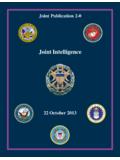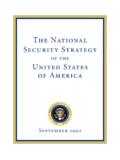Transcription of Criminal Intelligence Manual for Front-line Law …
1 *1056152* Criminal IntelligenceManual for Front-line Law EnforcementVienna International Centre, PO Box 500, 1400 Vienna, Austria Tel.: (+43-1) 26060-0, Fax: (+43-1) 26060-5866, December 2010 200 united nations publicationPrinted in AustriaCriminal IntelligenceManual for Front-line Law EnforcementUNITED nations office ON DRUGS AND CRIMEV iennaUnited nationsnew York, 2010 united nations , December 2010. All rights designations employed and the presentation of material in this publication do not imply the expression of any opinion whatsoever on the part of the Secretariat of the united nations concerning the legal status of any country, territory, city or area, or of its authorities, or concerning the delimitation of its frontiers or publication has not been formally production: English, Publishing and Library Section, united nations office at An introduction to Intelligence .. 12. The Intelligence 93. Example of a national Intelligence model: the united Kingdom.
2 174. Evaluation of source and data .. 255. Analysis and analytical 296. The role of analysis .. 357. Analytical techniques .. 43 4911. An introduction to intelligenceFROM INFORMATION TO INTELLIGENCEB efore we can properly discuss and explore information, Intelligence and analysis in theoretical and practical terms, we need to have some common understanding as to what these terms mean. Some definitions of these three key terms are as follows:Information- Knowledge in raw formIntelligence- Information that is capable of being understood- Information with added value- Information that has been evaluated in context to its source and reliabilityAnalysis (of either information or Intelligence )- The resolving or separating of a thing into its component parts- Ascertainment of those parts- The tracing of things to their source to discover the general principles behind them- A table or statement of the results of this processUnderstanding properly the difference between these terms and how they interact is important, however even at this early stage, these definitions point to key differences.
3 Information is quite simply raw data of any type, whilst in contrast Intelligence is data which has been worked on, given added value or way in which this transformation is made is through evaluation, a process of considering the information with regard to its context through its source and its simplest form, Intelligence analysis is about collecting and utilizing information, evaluating it to process it into Intelligence , and then analysing that Intelligence to produce products to support informed + EVALUATION = INTELLIGENCECRIMINAL Intelligence Manual FOR Front-line LAW ENFORCEMENT2 All these decisions involve applying our natural ability to analyse information, an overall process which can be usefully broken down into a series of stages, or questions we ask of ourselves, as follows: "What exactly is the problem; what decision do we have to make and why is it significant or important? "What information do we already have or might we reasonably obtain that could be relevant to the problem in hand.
4 Where is it/how can we get it? "What meaning can we extract from the information; what does it tell us about what s going on? "Is there only one possible explanation, or are there other alternatives or options. Are some more likely than others? "How do these affect the decision we have to make, are some options potentially better than others; do some carry greater risk of success and/or failure? "Are we ready to take action with a reasonable level of confidence, or do we need to gather more information first? If so, what else do we need and where/how can we get it?The process of applying these questions, evaluating the answers, and then choosing how to respond, to act, is the essence of what analysis is bringing this process under our conscious control, we can monitor it, develop and improve it, and subject it to quality checks which can be quite complicated to grasp. Beginning that development of awareness and skill is critical. The practical advantages of developing an individual s analytical skills are many, but can be summarized as follows:ANALYSIS GOES BEYOND THE FACTS It can tell you how good (or poor) your information/ Intelligence is It can tell you things you didn t know before It can tell you what you need to know to understand a situation It can tell you where to look further It can help you to communicate your understanding to othersThe origins of Intelligence analysisKnowledge has the potential to be equated to power.
5 The concept of collecting and utilizing information to support decision making in some formal, structured way is nothing new. In order to obtain advantage over adversaries, it is imperative to possess the most up-to-date, accurate information regarding amongst other things, their intentions and capabilities. This rule applies in every field, be it politics, business, military strategy, or Criminal Intelligence . In addition, it is a process that has always been, and still is, continually developing and evolving, in response to changes in social/cultural factors, technology, organizational needs, and new/higher levels of analytical the historical background, the roots of Intelligence and analysis as a process and as a profession is a useful and important exercise. Raising our understanding of the origins of Intelligence and analysis helps us to understand both where we are now and how/why we AN INTRODUCTION TO INTELLIGENCE3arrived at this point. It also raises our awareness of how Intelligence analysis is a continually changing, evolving practice, which if it is to remain relevant and useful in a practical sense constantly needs a fresh, flexible approach, new ideas, new skills, new techniques.
6 The one constant for the professional Intelligence analyst is that no two tasks or projects are ever exactly the same; every new piece of work requires a fresh are many examples throughout history of military, religious and community leaders actively tasking individuals with information-gathering exercises and then basing their decisions on the information obtained in this way. Perhaps the earliest recognized text on the subject of information gathering and Intelligence -based actions is The Art of War, The Art of Strategy written in the 5th Century BC by Sun Tzu, a Chinese mercenary warlord. He was renowned for his ability to command military campaigns whose success owed a lot to his effective information-gathering and Intelligence -led decision-making. It says much for the quality of this work that it still remains in print today, and is essential reading for military and corporate strategists and Intelligence operatives worldwide. From these early beginnings throughout history until relatively recent times, employing information-gatherers for primarily military goals has been a common is more, a methodology arose from this process that basically involved direct contact between the information gatherer(s) and the client/decision-maker, as illustrated on figure 1-1:Figure 1-1.
7 Basic tasking modelThis method had certain notable features:1) The sheer logistics involved (no real technology for transport or communication) created a massive time delay between the tasking of the information gatherer, the obtaining of the information, and the delivery of the information to the end-user .InstructiontaskingsupportRawinformation INFORMATION GATHERER(S)CLIENTP roduct (decision or action) Criminal Intelligence Manual FOR Front-line LAW ENFORCEMENT42) Using information collectors who operated by visiting locations and witnessing events either personally or through intermediaries guaranteed that the information collected would be limited by their senses and their ability to remember accurately what they saw; such infor-mation would thus always be highly subjective, and tend towards being based on opinion rather than ) The volume of information collected in return for such a large investment of time and resources would be extremely investigation generates vast amounts of information; the larger the enquiry, the more information the investigator has to deal with.
8 The problem for investigators is that no matter how good the system used to store all this information, they are always limited by their own mental capacity to embrace the information as a whole, to take it all in at understanding of the whole of the information is crucial to valid decision-making. Fully understanding a small part of the whole information available means that in fact the investiga-tor only has partial understanding of the whole might reasonably be taken as some measure of the importance and value of Intelligence and analysis that despite these potentially crippling limitations the process still proved to be a decisive factor in the success of military and political campaigns throughout these in acquiring information changed only slowly throughout history until towards the end of the last century. The massive growth in technology that began then, and still continues today, brought about what has proved to be a massive change in methods of information-gathering, which in turn created a demand for new approaches to analysis and process began in the late 19th Century with the advent of telegraphy and telephony, which allowed for messages to be sent almost instantaneously over greater and greater distances.
9 At a stroke this removed the resource and time problem that the former methods suffered through their need for the information gatherer to move between source and client. This change carried with it a number of , the response time between a client asking for information and receiving the result was vastly reduced; this represented a clear benefit in that it improved the clients ability to react quickly on the basis of such information. In addition, this development also had a knock-on benefit in that there was less time for the information source to forget or lose information whilst they were in transit, thus the quality of information also improved. Similarly, the lack of need for the information to be physically carried back to the client created a vast saving in resources; information gatherers were able to spend less time travelling/passing on information, and thus more time collecting overall result of this change was ironically that these benefits also carried with them a new problem for the client.
10 Much larger quantities of information were gathered, far more quickly than before, and the reaction time for making decisions was reduced. In addition, controlling the process of information-gathering itself became a problem, with a new need for more emphasis on new tasks and orders for information-gatherers created as a result of their new, improved UNDERSTANDING MUST INCORPORATE A DEGREE OF LEADS TO POOR INTRODUCTION TO INTELLIGENCE5 Thus where before the process involved information passing between information gatherer and client, because the new system created an information overload , a new problem arose in that the client simply was unable to process all the information received effectively and quickly and then react to analystA necessity arose for the client to return to a situation that enabled speedy interpretation of information and decision-making. This created a need for an intermediate stage between the information gatherer and the client, where the bulk of the information could be received, recorded, evaluated and examined to interpret and extract meaning, before the result of this process was passed to the client.
















